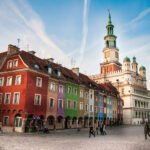Our map between the terms Cultural Heritage and European Cultural Heritage
Along the journey of our project, we are going to explore these two topics which refer to our patrimony as actual citizens of the European Union
Cultural Heritage
Find out about the cultural heritage from the native territories of our partners
Currently, the project will explore the cultural heritage from the native cities of Calabria, Poznan, A coruna, and Southampton

Definitions
History of the term Cultural Heritage and official literature
According to UNESCO
The term cultural heritage encompasses several main categories of heritage
Cultural heritage
Tangible cultural heritage
Intangible cultural heritage
oral traditions, performing arts, rituals
Natural heritage
natural sites with cultural aspects such as cultural landscapes, physical, biological, or geological formations
Heritage in the event of armed conflict

According to the European Commission
Europe’s cultural heritage is a rich and diverse mosaic of cultural and creative expressions, an inheritance from previous generations of Europeans, and a legacy for those to come. It includes natural, built, and archaeological sites, museums, monuments, artworks, historic cities, literary, musical, and audiovisual works, and the knowledge, practices, and traditions of European citizens.
While the policy in this area is primarily the responsibility of Member States and regional and local authorities, the EU is committed to safeguarding and enhancing Europe’s cultural heritage through several policies and programmes.
It is possible to read all the information to understand the definition of European Cultural Heritage on the link button below.

Cultural heritage: A driving force for the cultural and creative sectors
Cultural heritage enriches the lies of people. It is also a driving force for the cultural and creative sectors and plays a role in creating and enhancing Europe’s social capital. Cultural heritage is an important resource for economic growth, employment, and social cohesion.
Mapping EU support for cultural heritage in Europe
To celebrate the European Year of Cultural Heritage in 2018 the European Commission’s Joint Research Centre (JRC) developed a series of interactive maps to gather visual information related to heritage.
This web app features information about the following programmes and initiatives:
European Heritage Label
European Capitals of Culture
UNESCO World Heritage List in Europe
Information about the heritage under threat in Europe
Europe’s Digital Library
DiscoverEU
Cultural and Creative Cities Monitor
Cultural Routes of the Council of Europe
Cultural Gems
Cultural Gems maps cultural and creative places in European cities. It is a spin-off of the Cultural and Creative Cities Monitor, which assesses the performance of Cultural and Creative Cities in Europe. The tool is free and open-source and is developed by the JRC.
Find out more about Cultural Gems here








